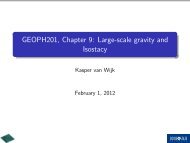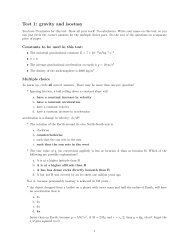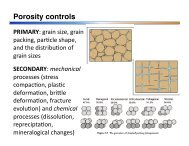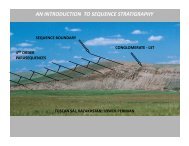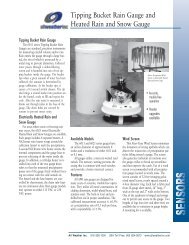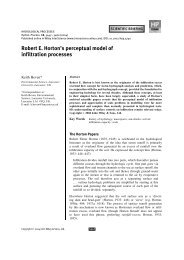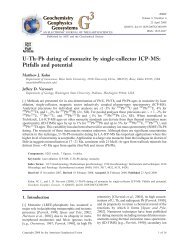Models of diffusion-limited uptake of trace elements in fossils and ...
Models of diffusion-limited uptake of trace elements in fossils and ...
Models of diffusion-limited uptake of trace elements in fossils and ...
You also want an ePaper? Increase the reach of your titles
YUMPU automatically turns print PDFs into web optimized ePapers that Google loves.
Trace element <strong>uptake</strong> <strong>in</strong> <strong>fossils</strong>? 3767<br />
The radius <strong>of</strong> (hydrated) mono- <strong>and</strong> divalent cations is<br />
comparable to (hydrated) LREE (+3) <strong>and</strong> U (+4) cations<br />
(S<strong>and</strong>ström et al., 2001), so D for REE <strong>and</strong> U <strong>in</strong> enamel<br />
is expected to be comparable, i.e., 10 8 cm 2 /s. The phosphate-fluid<br />
partition coefficient (K d ) is believed to be at least<br />
5 10 5 for U (Millard <strong>and</strong> Hedges, 1996) <strong>and</strong> 1 10 6<br />
for REE (Koeppenkastrop <strong>and</strong> De Carlo, 1992), with<br />
uncerta<strong>in</strong>ties <strong>of</strong> about one order <strong>of</strong> magnitude. Thus D eff<br />
is 62 10 14 cm 2 /s for U <strong>and</strong> 61 10 14 cm 2 /s for REE<br />
<strong>in</strong> modern enamel, with uncerta<strong>in</strong>ties <strong>of</strong> about 1 1 2 orders<br />
<strong>of</strong> magnitude. These values are 2–4 times lower than some<br />
rates derived from fossil fish dent<strong>in</strong>e (Toyoda <strong>and</strong> Tokonami,<br />
1990), <strong>and</strong> the estimated rate for U <strong>diffusion</strong> <strong>in</strong> bone<br />
(Millard <strong>and</strong> Hedges, 1996). Possibly calculated values for<br />
D eff <strong>in</strong> enamel reflect an adsorption rather than bulk equilibrium<br />
distribution coefficient, <strong>and</strong> both K d <strong>and</strong> <strong>in</strong>ferred<br />
m<strong>in</strong>imum t should be higher. Because the purpose <strong>of</strong> the<br />
<strong>in</strong>version is to provide a m<strong>in</strong>imum limit on t, however, use<br />
<strong>of</strong> the larger coefficients (2 10 14 cm 2 /s for U <strong>and</strong><br />
1 10 14 cm 2 /s for REE) is warranted.<br />
Substitut<strong>in</strong>g these values <strong>of</strong> D eff yields m<strong>in</strong>imum estimates<br />
<strong>of</strong> about a decade to produce the U pr<strong>of</strong>iles, <strong>and</strong> about a century<br />
for the REE pr<strong>of</strong>iles (Fig. 5 <strong>and</strong> Table 2). While these<br />
values may not realistically estimate total durations, they assuredly<br />
provide a lower limit. Fossilization <strong>of</strong> dent<strong>in</strong>e <strong>and</strong><br />
bone is expected to be many times faster because they have<br />
much higher porosity (Millard <strong>and</strong> Hedges, 1996), i.e., m<strong>in</strong>imum<br />
limits are on the order <strong>of</strong> years to decades. Large differences<br />
<strong>in</strong> fossilization rates among samples might be expected<br />
from different physical <strong>and</strong> microbial environments attend<strong>in</strong>g<br />
fossilization <strong>and</strong> <strong>trace</strong> element <strong>uptake</strong> <strong>in</strong> different materials.<br />
Yet all samples yield rather similar results for either REE<br />
or U pr<strong>of</strong>iles, irrespective <strong>of</strong> age. If <strong>trace</strong> element <strong>uptake</strong> <strong>in</strong><br />
these samples was governed by some common process, then<br />
the fact that the <strong>diffusion</strong> pr<strong>of</strong>iles <strong>in</strong> the 630 ka samples are<br />
no shorter than older samples implies that the older samples<br />
probably developed their <strong>diffusion</strong> pr<strong>of</strong>iles <strong>in</strong> 630 kyr, <strong>and</strong><br />
that fossilization <strong>of</strong> dent<strong>in</strong>e <strong>and</strong> bone occurred at least as<br />
quickly. This result supports other types <strong>of</strong> studies that assume<br />
relatively rapid (6100 kyr) alteration/<strong>uptake</strong> <strong>in</strong> bone<br />
<strong>and</strong> dent<strong>in</strong>e (e.g., Staudigel et al., 1985; Elderfield <strong>and</strong> Pagett,<br />
1986; Mart<strong>in</strong> <strong>and</strong> Haley, 2000; Trueman <strong>and</strong> Tuross, 2002;<br />
Kohn <strong>and</strong> Law, 2006; MacFadden et al., 2007; Zanazzi et<br />
al., 2007). Uncerta<strong>in</strong>ties <strong>in</strong> partition coefficients <strong>and</strong> hence<br />
D eff could reconcile the REE- <strong>and</strong> U-derived estimates. Generally<br />
shorter penetration distances for U compared to REE<br />
suggest lower D eff for U than for REE, <strong>in</strong> contrast to published<br />
K d ’s that suggest the opposite.<br />
Calculated durations are strict m<strong>in</strong>ima for two reasons.<br />
First, as described previously, K d may be underestimated,<br />
result<strong>in</strong>g <strong>in</strong> too large an assumed D eff . Second, preservation<br />
<strong>of</strong> the <strong>diffusion</strong> pr<strong>of</strong>iles requires some mechanism for<br />
retard<strong>in</strong>g D eff to values lower than measured <strong>in</strong> prist<strong>in</strong>e enamel,<br />
otherwise <strong>fossils</strong> older than 1 Ma would never preserve<br />
<strong>diffusion</strong> pr<strong>of</strong>iles. Occlusion <strong>of</strong> pore space via clays,<br />
metal oxides, <strong>and</strong> oxyhydroxides (Kohn et al., 1999) must<br />
ultimately shut down diffusive exchange <strong>of</strong> the enamel <strong>in</strong>terior<br />
with its marg<strong>in</strong>s. Therefore, the age <strong>of</strong> the youngest <strong>fossils</strong>,<br />
22–33 kyr, limits the maximum duration. The <strong>in</strong>ferred<br />
rates (>10–100 yr, but




